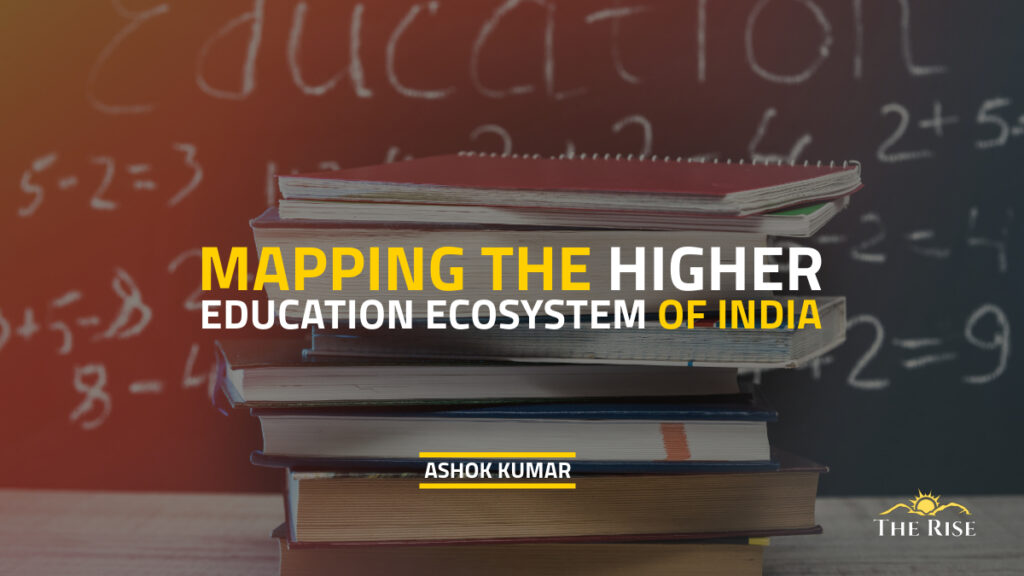The existing challenges paint a complex picture of India’s higher education ecosystem. Addressing them requires a multi-pronged approach, including increased funding, focus on equity and inclusion, curriculum reforms, investment in research and technology, and effective governance reforms.
The concept of higher education as an ecosystem is a relatively new one. But in present times, it has gained traction to understand the complex web of relationships and interactions that shape the landscape of post-secondary learning. The term “Higher Education Ecosystem” refers to the complex network of interconnected elements that influence and shape the experiences of students, faculty, and staff within the higher education landscape. This ecosystem encompasses a wide range of actors and factors. By considering the various actors and factors within the ecosystem, we can develop more effective strategies for improving access, quality, and affordability of higher education for all.
Also Read: Uniform Retirement Age of Teachers: A Panacea for Higher Education
Key components of this ecosystem:
Core Participants
- Students: The students who are the lifeblood of the ecosystem, come from diverse backgrounds, with varying goals. They seek knowledge, skills, and experiences to prepare them for their chosen careers and lives.
- Faculty and Staff: The educators, researchers, and administrators who provide the intellectual and operational foundation for the ecosystem. They design and deliver curriculum, research, and support student learning in and outside the classroom.
- Higher Education Institutions (HEIs): Universities, colleges, and other institutions offer formal degree programs and learning opportunities. They provide the physical and virtual infrastructure for learning, research, and community engagement.
- Employers and Industry Partners: The industries are the ultimate consumers of the graduates produced by the ecosystem. They provide internship and job opportunities, shape curriculum development, and collaborate on research projects.
Supporting Actors
- Government and Funding Agencies: Provide financial support for research, scholarships, and infrastructure development. They also set policies and regulations that shape the landscape of higher education.
- Technology Providers: Develop and implement educational technologies that enhance teaching, learning, and research. They also play a role in data analytics and personalized learning.
- Non-Profit Organizations and Advocacy Groups: Support students, faculty, and institutions through grants, scholarships, and advocacy efforts. They also promote access to quality higher education for all.
Also Read: The 3Ds of Post-COVID Classrooms: Distracted Students, Disruptive Ed-Tech, Declining Interactions
Interconnections and Relationships
These actors and elements are not isolated entities, rather they are interconnected and interdependent. Students learn from faculty, who conduct research funded by government agencies, which benefits industry partners who hire graduates. Technology providers develop tools that enhance teaching, which improves student outcomes, which in turn receives more funding, and so on.
Challenges and Opportunities
The higher education ecosystem faces numerous challenges, including rising costs, student debt, access inequities, and the need to adapt to a rapidly changing world. However, it also presents exciting opportunities for innovation, collaboration, and the development of new models of learning that are more flexible, accessible, and relevant to the needs of students and society.
India’s higher education ecosystem, teeming with millions of students and diverse institutions, grapples with numerous challenges that hinder its potential for excellence and inclusivity. Here are some key hurdles:
1. Access and Equity
- Limited Seats and High Competition: With 10 million students graduating high school annually, only 0.17 million seats are available in premier institutions, leading to fierce competition and unequal access.
- Regional and Socioeconomic Disparities: Quality education remains concentrated in urban areas and elite institutions, disadvantaging students from rural areas and lower socio-economic backgrounds.
- Gender Gap: Despite progress, women’s enrollment in higher education lags behind men, particularly in STEM (Science, Technology, Engineering, and Mathematics) fields.
2. Quality and Relevance
- Rote Learning and Outdated Curriculums: Emphasis on rote learning and outdated curriculums fails to equip graduates with critical thinking, problem-solving, and industry-relevant skills.
- Limited Research and Innovation: Low investment in research and development hampers innovation and restricts India’s contribution to the global knowledge pool.
- Faculty Shortages and Training Needs: Faculty shortages and inadequate training can compromise teaching quality and student engagement.
3. Affordability and Funding
- High Costs and Student Debt: Rising tuition fees and living expenses burden students, particularly those from disadvantaged backgrounds, potentially leading to debt and thereby hindering access to higher education.
- Inadequate Public Funding: Government spending on higher education remains below the recommended 6% of GDP, limiting resources for infrastructure, faculty salaries, and scholarships.
- Unequal Distribution of Funds: Funding disparities between elite and non-elite institutions exacerbate quality and access inequalities.
4. Infrastructure and Technology
- Uneven Infrastructure Distribution: Rural and remote areas often lack adequate infrastructure, including libraries, labs, and internet connectivity, thereby hindering access to quality education.
- Digital Divide: Unequal access to technology and digital literacy further disadvantages students from underprivileged backgrounds in online learning environments.
- Ineffective Integration of Technology: While technology offers immense potential, integrating it effectively into teaching and learning remains a challenge.
5. Governance and Regulations
- Rigid Bureaucracy and Outdated Regulations: Complex and inflexible administrative processes can stifle innovation and hinder the efficient management of institutions.
- Political Interference: Political influence in academic appointments and decision-making can compromise academic freedom and quality standards.
- Inadequate Accreditation and Quality Control: Ineffective accreditation processes and weak quality control mechanisms risk compromising the overall quality of higher education.
These challenges paint a complex picture of India’s higher education ecosystem. Addressing them requires a multi-pronged approach, including increased funding, focus on equity and inclusion, curriculum reforms, investment in research and technology, and effective governance reforms. By overcoming these hurdles, India can unlock the immense potential of its higher education system and empower its youth to contribute to the nation’s progress in a meaningful way.
Disclaimer: The views expressed in this article are of the author solely. TheRise.co.in neither endorses nor is responsible for them. Reproducing this content without permission is prohibited.
About the author
Prof. Ashok Kumar is former Vice-Chancellor of Deen Dayal Upadhyaya University, Gorakhpur (U.P.) & CSJM University, Kanpur, (U.P.), Nirwan University, Jaipur, Rajasthan, and Shri Kallaji Vedic University, Nimbahera, Rajasthan. He is President of the Social Research Foundation, International Society of Life Sciences.




























Pingback: Beyond Books and Bells: Organizational Citizenship Behavior